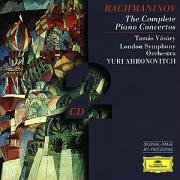| All Artists: Sergey Rachmaninov, Yuri Ahronovitch, London Symphony Orchestra, Tamas Vasary Title: Rachmaninov: The Complete Piano Concertos Members Wishing: 0 Total Copies: 0 Label: Deutsche Grammophon Release Date: 7/14/1998 Genre: Classical Styles: Forms & Genres, Concertos, Instruments, Keyboard, Symphonies Number of Discs: 2 SwapaCD Credits: 2 UPC: 028945313627 |
Search - Sergey Rachmaninov, Yuri Ahronovitch, London Symphony Orchestra :: Rachmaninov: The Complete Piano Concertos
 | Sergey Rachmaninov, Yuri Ahronovitch, London Symphony Orchestra Rachmaninov: The Complete Piano Concertos Genre: Classical
|
Larger Image |
CD Details |
CD ReviewsTruly stunning pianism Friedrich Pflueger | Poughkeepsie, NY United States | 12/01/2000 (5 out of 5 stars) "This 20 years+ old recording is one of the rare occasions where every little detail fell exactly into place. Yes, Vasary is technically far above the pianistic challenges, to a degree that makes you forget all that ink in the scores (e.g. No. 3). But in all the whirling of Rachmaninov's breathtaking modulations and chromatic shifts, long arched melodies always remain at the center of the musical flow. Vasary is confident enough to give the orchestra full equality in the dialog, and Ahronovitch will let you hear a microcosm of motifs and phrases in the orchestra that you haven't heard before. The knife-edge transparency, rich tone, and balance captured by DGG's sound engineers are without parallel both in studio and live recordings (Rachmaninov, Kissin). But above all: a towering competence of Vasary at the piano. The ease and precision in the technical passages, equalled only by Richter, will make you hear hard labor in your other recordings (e.g. Ashkenazi, Kissin). The phrasing is full of life, but rubati are very modest and musical -- no need to push, like Rachmaninov himself does, what already are emotionally loaded scores. Listen to the cadence in No.3 (ossia) for what full impact piano music can be. And find out that No. 1 and 4 are masterpieces of high rank, neglected for historic rather than musical reasons." Vásáry's Rachmaninoff concerti Jeffrey Jones | Northern California, USA | 04/19/2001 (5 out of 5 stars) "Tamas Vasary is better known for his fantastic, pulsating Chopin, but he has also put down readings of the Rachmaninoff concertos that are utterly unique. Both he and conductor Ahronovitch clearly operate on the principle that you should be able to hear everything. While Vasary is clearly the soloist when it's his turn, Ahronovitch shows his appreciation for Rachmaninoff's orchestrational skill by bringing out melodic fragments that are too often covered by, for example, a thundering pianist. More high marks for the sheer beauty. The sound is lovely, coated in sun, atmospheric. The Third Concerto has not a winter storm, as many recordings do, but instead the swirl of autumn leaves. The Second is less successful, sounding rather ponderous and mechanical, but the First is a structural tour de force, and the Fourth is the most pleasing I have heard it. The major downside of the relaxation exhibited in these readings is that it comes at the expense of forward motion. The Third concerto takes 44 minutes total, and the first movement is nearly 18 minutes thanks in part to Vasary's use of the longer, alternate cadenza that Rachmaninoff himself never used. He is not, however, as slow as Ashkenazy, and the tempi certainly still fall within the realm of reason. The fresh perspective on this battered, overused music is well worth the wait." Holy Cow John Buie | United States | 03/06/2000 (5 out of 5 stars) "Holy Cow! Just when I thought I had all the versions of Rachmaninov's second piano concerto a music collector could ever need, I find this performance which by any standard could only be called definitive. For that is exactly how I would describe Vasary's astonishing rendition of this popular work. I was bowled over by the pianist's virtuosity in the first movement (he's clearly in the Richter class), but it was the Adagio that totally did me in. This is the most beautiful rendition of Rachmaninov's haunting melody that I have ever heard. To me, the Adagio alone makes this set worth the price of admission. Ah, but there's more! Vasary likewise gives a brilliant and stirring performance of the flamboyant third concerto. Although I do not own as many versions of this work as the one mentioned above, Vasary's performance easily rivals all others I have heard and excels the only version in my collection. Bravo!"
|

 Track Listings (6) - Disc #1
Track Listings (6) - Disc #1